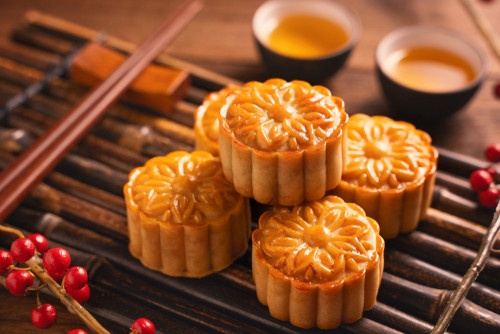Popular Reads
Top Results
Can't find what you're looking for?
View all search resultsPopular Reads
Top Results
Can't find what you're looking for?
View all search resultsIt's the season of the mooncake
The mooncake is the delicacy of the Mid-Autumn festival which officially starts on October 1.
Change text size
Gift Premium Articles
to Anyone
This little cake generally measures not more than 10 cm. It is typically golden in color and can be devoured in three bites.
The mooncake is the delicacy of the Mid-Autumn festival which officially starts on Oct. 1. This traditional delicacy, eaten in China, Hong Kong, Malaysia, the Philippines and Vietnam, is supposed to be a symbol of happiness.
The second largest event in Chinese culture after New Year's Day, the Mid-Autumn Festival -- also known as the Moon Festival -- traditionally takes place on the 15th day of the eighth moon in the Chinese calendar. This tradition dates back more than 3,000 years ago when communities prayed to the moon to bring good harvests.
Even today, Chinese families gather together to make sure they fete this event, during which paper lanterns are lit. During this festival, whose practice has spread to a large part of Asia, from Vietnam to the Philippines, Malaysia and Japan, mooncakes are made and/or exchanged.
The round shape of these cakes evoke the family gathering. They are also believed to symbolize happiness. Traditional inscriptions on the cake are the Chinese calligraphic symbols for "longevity" or "harmony." To represent the full moon, the cake usually hides in its center a fermented duck egg yolk.
Several legends explain the connection of the mooncake with the Mid-Autumn festival. One suggests that the mooncake played a major role in the Chinese rebellion against the Mongols at the end of the Yuan Dynasty between 1280 and 1368. Zhu Yuanzhang was a rebel who had the idea to distribute small cakes to the Chinese population in which he slipped a message calling on his compatriots to raise their arms on the 15th day of the eighth moon. The plan worked and the leader became the founding emperor of the Ming Dynasty.
Another explanation goes back even further in history to explain the custom of the mooncake. Emperor Taizong, who reigned from 626 to 649, received cakes as a gift on the occasion of a victory against nomadic tribes in Central Asia on the 15th day of the eighth moon. The leader is said to have shared the gift with his ministers and then made it a tradition.
Read also: Hong Kong festival mooncakes get a protest makeover
What does a mooncake taste like?
There is no one single recipe for mooncake. Although it is often homemade in the family, the type of ingredients differs, especially according to region.
One traditional version is based on a mixture of almonds, walnuts and pumpkin and sesame seeds, which is combined with roasted pork. The other recipe that often serves as a reference is based on an ingredient that is widely used in Asian pastries: red bean paste. The consistency is dense, even elastic, with a very mild flavor.
In Guangzhou, and in southeastern China, lotus seed paste is used. But due to the high price of the product, it tends to be replaced by red bean paste.
In Hong Kong, the difference is that mooncakes are not baked in the oven. They often use... frozen sticky rice! Sometimes fruit juice is added to color the crust. And these days, there are many versions -- one can find them filled with vegetables, fruits, chocolate, even seafood!











